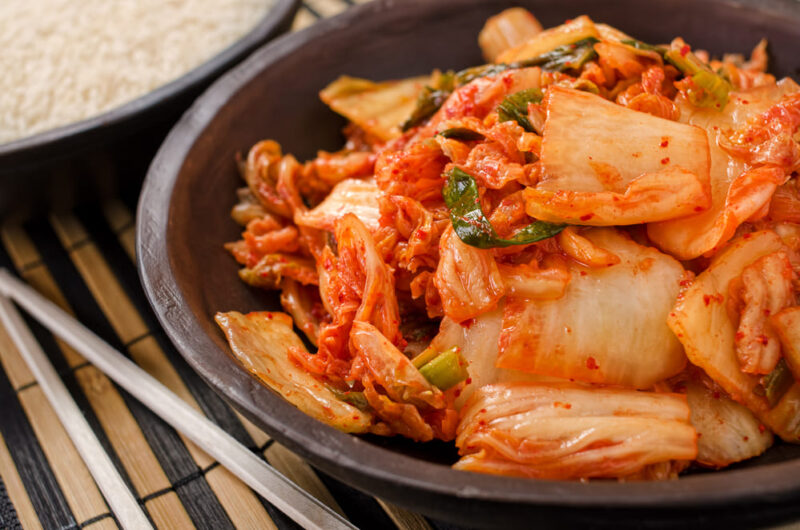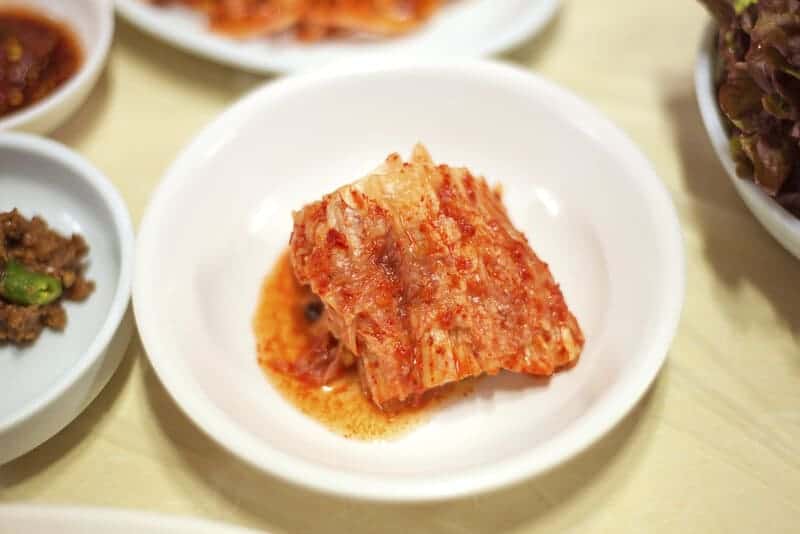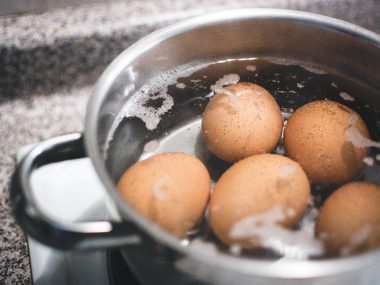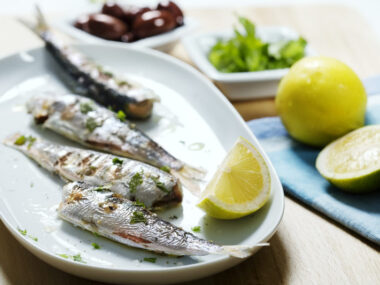Kimchi is one of the healthiest foods you can have and it is just as delicious, but if you never had Kimchi, you will be curious about the taste of this dish, so you can get an idea before you give it a try.
It is hard to pin the flavor of Kimchi down to one word as it can be complex and differs from one recipe to another. However, as soon as you taste it, you will experience a unique umami flavor, nicely complemented by a spicy and sour taste.
Keep reading and you will find everything you need to know about this delicious, Asian dish!
How to Make Kimchi?
If you want to make the best kimchi, we have the ideal recipe for you. It might not be the easiest dish to prepare, especially if you are a beginner, but we assure you that it will be worth it!
Homemade Kimchi Recipe
The first thing to do when you want to make kimchi is to get all your ingredients ready.
Ingredients:
- Water
- 1 medium head of Napa cabbage (about 2 pounds)
- 1/4 cup iodine-free sea salt or kosher salt
- 1 tablespoon grated garlic (5-6 cloves)
- 1 teaspoon grated peeled fresh ginger
- 1 teaspoon granulated sugar
- 2 tablespoons fish sauce or salted shrimp paste or 3 tablespoons water
- 1-5 tablespoons Korean red pepper flakes (gochutgaru)
- 8 ounces Korean radish or daikon radish peeled and cut into matchstick,
- 4 medium scallions, trimmed and cut into 1-inch pieces
It might seem like a lot of ingredients but once you start cooking you will see there are not so many!
Step 1: Prepare the Cabbage
Cut the cabbage into strips that are two inches wide. Make sure you cut it in length, through the stem for the best outcome. You might be able to find cabbage already cut at your grocery store, so it is worth checking that option out.
Step 2: Season the Cabbage
Put the cabbage in a bowl and add salt. Add water to the bowl until it covers the cabbage. Make sure the salt reaches all the cabbage and cover the bowl with a plate.
It is crucial to put a jar or a heavy item on top of the plate to press the cabbage inside the bowl. Then, let it sit for up to 2 hours.
Step 3: Drain the Cabbage
Before you can use the cabbage in your kimchi, you will have to drain it, then rinse it. Rinse the cabbage 3 different times with cold water to get it ready for your kimchi.
Step 4: Prepare the Spices
Get a bowl and add the garlic, sugar, ginger, shrimp paste, and fish sauce or water before you mix them all.
Keep stirring the ingredients until you obtain a pasty sauce.
You can also taste this paste and see if you like it. If you feel like you could use more of a certain ingredient, this is the right time to adjust the quantity.
Once you pack the kimchi in the jar, you will not be able to adjust its flavor.
Step 5: Add Spice to the Vegetables
Add the spices to the veggies and also add any remaining water from the cabbage. You don’t have to add too much water because you don’t want your kimchi to be too runny.
Enough water to cover the mixture is plenty as most of it will be absorbed by the ingredients in your kimchi.
Also, add scallion and radish to the vegetables at this point. Mix everything well until everything is nicely blended.
Step 6: Mix Everything Throughout
Make sure the veggies are covered by the seasonings. You will have to use your hands for this step and you might even want to use gloves as well. However, the gloves are optional.
Step 7: Arrange the Kimchi Into a Jar
Add the cabbage and the veggies into the jar and press well until the liquid rises on top of the mix. Seal the jar with an airtight lid. We recommend putting a bed of cabbage inside the jar so the rest of the ingredients will arrange smoothly on it.
Step 8: Let Your Mix Ferment
The fermentation time is between one and five days. Keep your kimchi at room temperature, and out of the sun. As it ferments, your kimchi will start making bubbles on the surface of the mixture and this is a great sign.
Step 9: Refrigerate and Serve as You Please
Once your kimchi is ready, you can store it in the refrigerator and take out as much as you need for your meals. Kimchi tastes even better if it stayed two weeks in the fridge.
Where Does it Come From?
Kimchi has a history of 3,000 years and it is a traditional Korean dish. It was invented as Koreans were trying to find the best way to preserve vegetables during the winter and have food all year round. And the recipe that won is the same that people use to prepare Kimchi today.
Is Kimchi Spicy or Sour?
Kimchi is both spicy and sour.
However, the flavor of this dish will differ depending on how much seasoning you add to it as well as the time you give it for the fermentation process.
Kimchi that stayed to ferment for a day will taste different than one that stayed five days.
In the traditional recipe, your kimchi will taste more sour than spicy due to the fermentation. The garlic has a strong influence on the final taste of the dish.
It can also make the difference between good kimchi and a blunt one.
Can You Eat Kimchi by Itself?
One of the main qualities of this dish is that you can enjoy it straight from the jar.
Of course, it will taste much better as a side dish next to pasta or steak. However, if you like how it tastes plain, you can feel free to enjoy it like that.
Does Kimchi Taste Like Vinegar?
Kimchi has a strong sour taste but it is not as strong as vinegar.
However, due to the fermentation phase, this dish will taste as if you added vinegar to it when, in fact, it is just a result of giving it time to mature into the pickle dish you want it to be.
What Does Kimchi Smell Like?
The smell of kimchi is quite strong as well, but it is not an unpleasant smell. Typically, this dish smells like pickles.
The sour smell could be more or less pungent depending on how much seasonings you add to it. Also, the more your kimchi stays to ferment, the stronger the smell will be when you open the jar.
Does Kimchi Taste Like Fish?
Many people think that kimchi has a fish taste. Actually, the taste has somewhat of a seafood flavor. The fish flavor is not that strong to take over the other flavors so it will not be the first one you notice when you taste your kimchi.
However, there is a fish flavor that you will not be able to ignore as you taste your kimchi and until you get used to it, you might think it is more prominent than others.
Is Kimchi Vegetarian?
Since kimchi contains fish sauce, it can’t be considered a vegetarian dish.
You can still make kimchi without the fish sauce, but the flavor you yield will not be the same as the traditional one. However, there are variations of this dish that don’t include fish sauce.
Does Kimchi Taste Good?
Does kimchi tastes good or not is a matter of personal preference. However, if you don’t like the Korean recipe, you can always adapt it to the best of your preferences.
We suggest adjusting the seasonings and tasting your kimchi as you prepare it. If you prefer the seasoning paste, chances are that you will like the final dish as well.
Therefore, feel free to adjust this dish to get just the right flavor that will please you taste buds. However, don’t increase the amount of sauce. Kimchi that is too salty is not the best option for such a dish.
There will be plenty of delicious flavors to achieve from the rest of the ingredients. So, making your kimchi too salty is not the solution to get it closer to your taste preference.
Would You Give Kimchi a Try?
Kimchi goes great with rice but also as a side dish for soups, stews, steaks, and even plain. Since it has such a rich flavor, many people love kimchi by itself or with some toast.
A classic combo in Korea is rice with kimchi and a fried egg, but you can let your imagination run free as you are using this tasty, Asian food and you will not fail. It is very flexible and you can make a large quantity to have for a longer time.
Any type of food will have a richer taste if you enjoy it with a bit of kimchi on the side!



